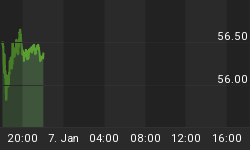Some investors seem disappointed with the Federal Reserve's apparent failure to endorse another round of quantitative easing. While the fragility of the EU continues high, the ECB also seems to have no taste for another round of quantitative easing. All of this is causing great unhappiness. Reality seems to have clashed with the child like expectations of so many investment strategists. That is understandable, for the whole house of cards and fantasies of much of the hedge fund industry are dependent on a continued flow of easy money. The rest of us should be somewhat more pleased that the Federal Reserve is not pursuing QE-Dysfunctional.

The above chart plots long term wealth indices for the price of $Gold, red line, and the total return on the S&P 500, solid black line. This chart allows us to assess the success or failure of U.S. monetary policy over the past twenty years. That period includes two of the most inept monetary regimes ever to run the central bank of a major economy.
On balance, over the period shown Gold, that archaic anachronism, has performed nearly the same as the equity of the largest economy in the world. This dead asset has done as well as an investment in the entire U.S. economy. That comparison alone demonstrates the dysfunctional nature of Keynesian mythology, and dubious wisdom of the high priests of that theology. U.S. investors and the citizens of that nation might have done better with Clifford, the Big Red Dog, in charge of the Federal Reserve.
Perhaps a more important message is shape of the black line, the total return on the S&P 500. In the beginning, the easy money policy of the Greenspan era did enhance returns. The total return line rose to the first high in the chart. The literature of finance does say that leverage, borrowed money, will at first enhance return on equity.
However, each successive round of monetary sorcery, quantitative easing, did nothing but increase the volatility of an investment in the equity of the U.S. Investors have essentially earned nothing net over much of the last decade or so. Rather, the value of their investments has done nothing more than move up and down in violent fashion. More recently, consequences have been to again fund investment fantasies such as that of AAPL reaching $1000, which is likely to happen when Clifford, the Big Red Dog, begins to fly. All in all, the Federal Reserve has clearly demonstrated again that its policies truly are QE-Dysfunctional.
What might be some implications of the end of the anticipating QE-3? For one, the dollar is not going to crash, at least this year. Gold is not going to $2,000 and Silver is not going to $100 this year. Proponents of those forecasts will again have to change the date for their arrival, as they have been doing for years. More realistic is that $Gold will first test the $1,600 level before testing the $1,530 low. Silver will, due to its high Gold beta, test the $27 low. At those prices we are likely to become far more aggressive in recommending their purchase as much of the impact of the QE nonsense will have been removed.

On of the bigger risk during in the immediate future may be in the above chart of the index for junior mining stocks. For some time it has been failing to make new highs while making new lows, the classic footprints of a bear. It this week broke to a new low, validating again the bear market for junior mining stocks. This is an investment group headed for gut wrenching pain this Summer. However, we expect that in August some true bargains will develop.
Oscillator in the above chart is a stochastic. It seems now to be doing what so many indicators do in a bear market. Most indicators will in a bear market give repetitive over sold readings that makes their use risky. The very nature of a bear market is to over sell things, and that naturally influences the indicators. In a bull market, the reverse happens. The indicators in that environment give repetitive over bought readings. So, as we warn our readers, be careful how one responds to these readings.
In sum, now is the time to be build cash for coming opportunities to buy. For remember, in a bear market future returns are being created. By end of Summer some very nice future bull market returns may have been created.
GOLD THOUGHTS come from Ned W. Schmidt,CFA,CEBS as part of a now victorious mission to save investors from what became the financial abyss of paper assets, and the now the great Silver Bear Market. He is publisher of The Value View Gold Report, monthly, and Trading Thoughts. To receive these reports, go to: www.valueviewgoldreport.com
















